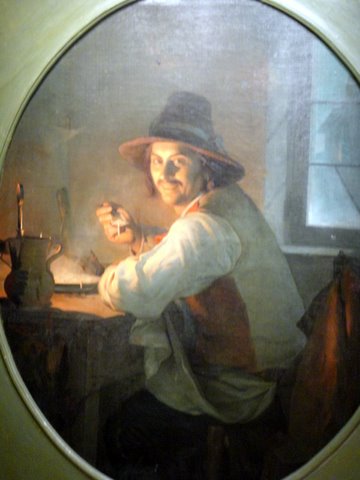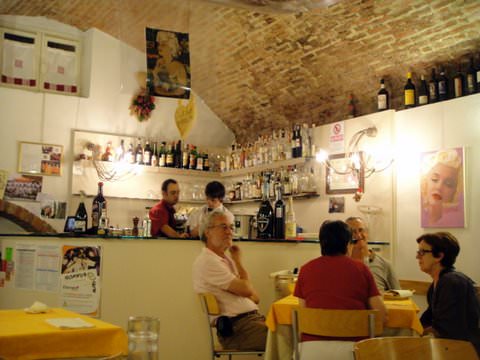Walking through Asti’s narrow cobble-stoned streets and 18th-century squares is the best kind of time travel: you’re transported back through history, but you can stop almost anywhere along the way for a great meal and a glass of wine, and end the day in a modern, comfortable hotel room. Asti is a mid-sized town in the Tanaro River valley of the Piedmont region of northwestern Italy. Its complicated history began  when it was a fortified Roman camp, then was invaded by Visigoths. Asti was an active power in the Middle Ages, fell, rose again, and today is a bustling place noted for its foods and wines. Our tour started with a walk from Hotel Lis to Palazzo Mazzetti , on Corso Vittorio Alfieri, Asti’s main street. Our guide, Ameriga Vozza, took us through the restored palace, now a museum with a wide staircase leading to Italian paintings and carvings and a few 18th-century furnishings. Most intriguing to me were the 19th century paintings by Michelangelo Pittatore and the 250-year-old miniature sculptures by Giuseppe Maria Bonzanigo. The detail on these micro-works is astonishing.
when it was a fortified Roman camp, then was invaded by Visigoths. Asti was an active power in the Middle Ages, fell, rose again, and today is a bustling place noted for its foods and wines. Our tour started with a walk from Hotel Lis to Palazzo Mazzetti , on Corso Vittorio Alfieri, Asti’s main street. Our guide, Ameriga Vozza, took us through the restored palace, now a museum with a wide staircase leading to Italian paintings and carvings and a few 18th-century furnishings. Most intriguing to me were the 19th century paintings by Michelangelo Pittatore and the 250-year-old miniature sculptures by Giuseppe Maria Bonzanigo. The detail on these micro-works is astonishing.
We continued on Corso Alfieri to the Gothic cathedral, Santa Maria Assunta, the largest cathedral in Piedmont. Built in the14th century, it holds intricate carvings, frescoes, and fine paintings that include notable works from the Renaissance by Gandolfino d’Asti. Asti has a number of other churches, such as Santa Maria Nuova, the Baptistery of St Peter, the Baroque church of St. Catherine, and San Pietro in Consavia, where the archeological museum is located. (Some churches are closed except during religious services; check for times with the tourist information office.) Ameriga pointed out a series of medieval towers that were built when Asti was a major power and so many wealthy families built ever-higher towers. Consequently, Asti became known as “the city of 100 towers.” Troyana Tower, on Piazza  Medici, is one of the city’s main symbols and, at 144 feet, the highest in Piedmont. It’s the only one open to visitors and worth a climb to the top for the marvelous view of the city, Tanaro River, and countryside (open weekends April-October). The Red Tower (Torre Rossa), which may have been part of a Roman gate, is known as the place where Asti’s patron saint, San Secondo, was imprisoned before he was beheaded for his beliefs. He is said to have been martyred in 119 C.E. on the site where the San Secondo church now stands.
Medici, is one of the city’s main symbols and, at 144 feet, the highest in Piedmont. It’s the only one open to visitors and worth a climb to the top for the marvelous view of the city, Tanaro River, and countryside (open weekends April-October). The Red Tower (Torre Rossa), which may have been part of a Roman gate, is known as the place where Asti’s patron saint, San Secondo, was imprisoned before he was beheaded for his beliefs. He is said to have been martyred in 119 C.E. on the site where the San Secondo church now stands.
On that cheery note we stopped for a casual lunch (with a light fizz of Moscato d’Asti) at an outdoor table at Tuit, a café that is part of Eataly, the popular restaurant/deli/food chain. My salad was fresh and crisp, and the chocolate gelato as good as any I’ve tasted in Italy, home of the world’s best gelato. Our dinner at Tacabanda, near the Alfieri Theater, was excellent. The below-stairs restaurant is in an old cellar with a vaulted ceiling, but it’s light, bright, and modern, with a Marilyn Monroe theme, and has an admirable wine collection. One evening we found the Magic Flute, in Hotel Ristorante Reale, and enjoyed a fine meal of sea bass with olives, potatoes and tomatoes. Ristorante Barolo, an underground cantina, is reputed to serve creative versions of traditional specialties and has a wide wine selection. We also were told that Campanaro, though quite small, is one of the best in town.
 Some of the region’s classic foods are hazelnuts, salamis, meats, goat cheese, and truffles. Vegetables are stacked in colorful piles in outdoor markets: fat artichokes, bright green asparagus, square peppers, lush tomatoes, “hunchbacked” cardoon (so called because of the sharp curve at one end). Apples, peaches, and cherries are abundant, and of course there are many very good local wines. Vineyards in this area produce 40% of Piedmont wines, including the famous Asti Spumante. All of this and more are celebrated at Festival delle Sagre, in the fall. This huge fair in Campo del Palio displays the region’s products to thousands. Whether visiting during festival time or not, don’t leave without tasting Asti’s sweets. The favorite, sold in the colder seasons, is Torrone, a nougat of honey, hazelnuts, egg whites, and vanilla. Giordanino, the oldest candy shop in Asti, sells them, along with cookie-like amaretti and other treats.
Some of the region’s classic foods are hazelnuts, salamis, meats, goat cheese, and truffles. Vegetables are stacked in colorful piles in outdoor markets: fat artichokes, bright green asparagus, square peppers, lush tomatoes, “hunchbacked” cardoon (so called because of the sharp curve at one end). Apples, peaches, and cherries are abundant, and of course there are many very good local wines. Vineyards in this area produce 40% of Piedmont wines, including the famous Asti Spumante. All of this and more are celebrated at Festival delle Sagre, in the fall. This huge fair in Campo del Palio displays the region’s products to thousands. Whether visiting during festival time or not, don’t leave without tasting Asti’s sweets. The favorite, sold in the colder seasons, is Torrone, a nougat of honey, hazelnuts, egg whites, and vanilla. Giordanino, the oldest candy shop in Asti, sells them, along with cookie-like amaretti and other treats.
 Tip: Traveling on your own, it’s helpful to carry “Asti In Your Pocket,” a handy booklet and map free from the tourist office on Piazza Alfieri. If you prefer a guide, I highly recommend Ameriga Vozza. Experienced and especially knowledgeable about the region’s specialties in food and wine, she leads tours around Italy. Her particular focus is Piedmont wine country.
Tip: Traveling on your own, it’s helpful to carry “Asti In Your Pocket,” a handy booklet and map free from the tourist office on Piazza Alfieri. If you prefer a guide, I highly recommend Ameriga Vozza. Experienced and especially knowledgeable about the region’s specialties in food and wine, she leads tours around Italy. Her particular focus is Piedmont wine country.
Asti is a 40-minute drive from Turin and an hour from Milan; and by train about two hours from Milan.
This tour was partially hosted by the Italian Government Tourist Office and Asti Tourism.
Written by and photos by Marilyn McFarlane for EuropeUpClose.com

Julo, Best of European Union
Monday 19th of December 2011
I haven't heard about Asti before, seems to be quite an interesting place. I would like to taste a local wine and fish in that restaurant on photo :)
Kerala tour package
Monday 19th of December 2011
The Collection of the travel blog is very beneficial to me for my tour trip
Tim
Monday 12th of December 2011
Thanks for your guidance
puertoricoistheplace
Thursday 8th of December 2011
Looks like a nice and interesting place! Love Italy, will have to visit one day. Thanks for sharing.